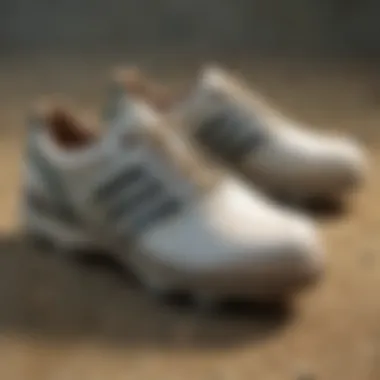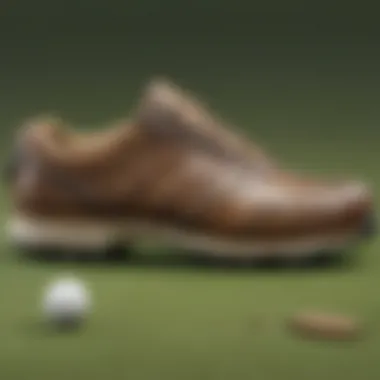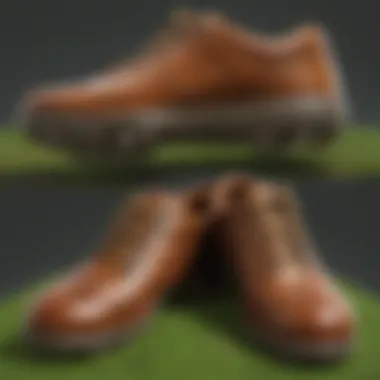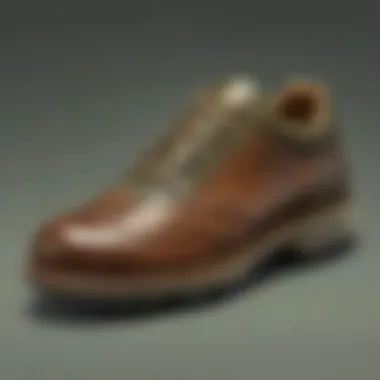Ultimate Guide to Replacing Soft Spikes in Golf Shoes for Optimal Performance


Golf shoes play a crucial role in a golfer's performance on the course, and one key component that often requires attention is the soft spikes. In this comprehensive guide, we will delve into the importance of soft spikes, how to identify signs of wear and tear, a detailed step-by-step process for replacing them, the different types of replacement spikes available, and essential maintenance tips to ensure optimal traction and performance.
Importance of Soft Spikes
Soft spikes are small cleats on the sole of golf shoes that provide traction and stability during the golf swing. They help prevent slipping on various terrain types, especially wet or uneven surfaces. Maintaining proper soft spikes is essential for a golfer's balance and grip while playing, ultimately influencing their overall game performance.
Signs of Wear and Tear
Over time, soft spikes wear down due to constant pressure and friction against the ground. Signs of wear include decreased grip, uneven cleat length, and visible damage to the spikes. It is recommended to regularly inspect soft spikes for any signs of wear and replace them promptly to ensure consistent performance on the course.
Step-by-Step Replacement Process
Replacing soft spikes is a simple yet crucial maintenance task for golfers. Start by securing the necessary tools, such as a spike wrench or removal tool. Carefully remove the old spikes by twisting them counterclockwise, then clean the spike receptacles thoroughly. Next, align the new spikes with the receptacles and twist clockwise to secure them in place. Repeat the process for all spikes, ensuring they are evenly placed for balanced traction.
Types of Replacement Spikes
There are various types of replacement spikes available, including metal, ceramic, and plastic options. Metal spikes offer excellent grip but may damage the green, while ceramic and plastic spikes provide adequate traction without causing harm to the course. Choose replacement spikes based on personal preference, course regulations, and playing conditions to optimize performance and minimize potential course damage.
Maintenance Tips
To prolong the lifespan of soft spikes and enhance their effectiveness, golfers should adopt regular maintenance practices. This includes cleaning spikes after each round, storing shoes in a cool and dry place, and periodically checking for signs of wear. Additionally, rotating the position of spikes can help distribute wear evenly across the sole, extending their usability and maintaining optimal traction.
Introduction
Golfers understand the significance of proper equipment for enhancing their performance on the course. Among these essential equipment are soft spikes for golf shoes. This guide delves deep into the world of soft spikes, offering invaluable insights into their replacement and maintenance. By comprehensively understanding soft spikes, golfers can elevate their game and ensure a firm grip on every swing.
Purpose of the Guide


Soft spikes form a crucial component of a golfer's arsenal, directly impacting their traction, stability, and performance on the turf. This section elucidates the primary objective of the guide, which is to aid golfers in seamlessly replacing their worn-out spikes with new ones. Golfer enthusiasts are to understand the step-by-step process and nuances involved in maintaining their spikes for optimum play.
Benefits of Soft Spikes
Soft spikes bring several advantages to golfers, ranging from improved traction to the prevention of slipping on the golf course. By elaborating on these benefits, golfers can grasp the significance of well-maintained spikes for their overall game. The section outlines the direct impact soft spikes have on a golfer's stability, balance, and movement during swings, thereby underlining their essential role in the sport.
Overview of the Replacement Process
Replacing soft spikes is a meticulous task that requires attention to detail. This section provides a comprehensive overview of the replacement process, from the tools required to the crucial steps of removing old spikes and installing new ones. By understanding this process meticulously, golfers can ensure a seamless transition and maintain their shoes in top condition for consistent performance on the golf course.
Importance of Soft Spikes
Soft spikes are a crucial component of golf shoes, essential for maintaining stability and grip on the golf course. Without proper spikes, golfers risk slipping and losing their balance during swings, affecting their performance and potentially leading to injuries. The design of soft spikes is optimized to provide traction on different terrains, ensuring a secure footing in various weather conditions. Additionally, soft spikes contribute to the longevity of the golf course by minimizing damage caused by traditional metal spikes. As golf is a precision sport that demands consistency in every shot, having the right soft spikes can make a significant difference in a player's confidence and overall game performance.
Enhanced Traction
Enhanced traction is one of the primary benefits of soft spikes in golf shoes. These spikes are strategically placed to maximize contact with the ground, delivering enhanced stability during the golf swing. The design of soft spikes allows for improved weight distribution, minimizing slippage and improving overall balance. This enhanced traction translates to better control over the swing, enabling golfers to generate more power and accuracy in their shots. Whether navigating bunkers, roughs, or fairways, soft spikes provide the necessary grip to navigate varying terrains with confidence and precision.
Prevention of Slipping
The prevention of slipping is a critical aspect of soft spikes' functionality. Unlike traditional metal spikes that can dig into the ground and potentially cause damage, soft spikes offer a safer alternative by providing sufficient grip without damaging the course. By preventing slipping, golfers can maintain a fluid and uninterrupted swing motion, reducing the risk of mishits and errant shots. This security in footing instills confidence in players, allowing them to focus on their game strategy and technique without concerns about slipping or losing balance during critical shots.
Protection of the Golf Course
Soft spikes play a crucial role in protecting the golf course's turf and greens. The flexible and non-abrasive nature of soft spikes ensures that they do not tear up the grass or leave unsightly marks on the course, preserving its aesthetic appeal and playability. By opting for soft spikes instead of metal alternatives, golfers actively contribute to the sustainability and maintenance of the golf course. The distribution of pressure across multiple soft spikes reduces the impact on specific areas, preventing wear and tear and promoting the overall health of the course. Ultimately, the protection of the golf course is a collective responsibility that begins with choosing the right equipment, including soft spikes, to minimize ecological damage and preserve the beauty of the game's natural environment.
Signs of Wear and Tear
Signs of wear and tear are crucial indicators that alert golfers to the deteriorating condition of their soft spikes, necessitating timely replacement. As golfers traverse the course, their shoes endure substantial stress, leading to wear on the spikes. This section will delve into the key signals that golfers need to watch out for to maintain optimal performance on the green. By understanding and recognizing these signs early on, golfers can prevent performance setbacks and potential hazards during their game.


Smooth or Worn Out Spikes
Smooth or worn-out spikes are a clear indication that the spikes have lost their original grip and traction. As these spikes wear down, they become smoother, decreasing their ability to grip the turf effectively. This diminished traction can significantly impact a golfer's stability and balance during swings, potentially resulting in inconsistent performance. It's essential for golfers to regularly inspect their spikes for any signs of smoothness or excessive wear to ensure they replace them promptly and maintain peak performance levels.
Loose Spikes
Golfers must pay close attention to any loose spikes on their golf shoes, as these can pose a significant safety risk during play. Loose spikes can affect a player's stability and balance, increasing the likelihood of slips or falls on the course. Furthermore, loose spikes can cause discomfort and distraction, hampering a golfer's focus during crucial shots. Regularly checking for loose spikes and promptly tightening or replacing them is vital to mitigating these risks and ensuring a safe and productive golfing experience.
Uneven Traction
Uneven traction is another critical sign of wear and tear that golfers need to be mindful of when assessing the condition of their soft spikes. Uneven traction occurs when certain spikes wear down at a faster rate than others, leading to an inconsistent grip on the turf. This irregular traction can cause imbalances in weight distribution during swings, impacting the quality and accuracy of shots. Golfers must address uneven traction promptly by replacing all spikes to maintain uniform grip and stability across all movements on the course, optimizing their playing experience.
Step-by-Step Replacement Process
The Step-by-Step Replacement Process is a crucial aspect of this comprehensive guide on replacing soft spikes for golf shoes. By understanding and executing this process effectively, golfers can enhance their performance and ensure optimal traction on the course. This section will delve into specific elements, benefits, and considerations regarding the replacement process, guiding golfers through each step with precision and clarity.
Tools Required
When embarking on the soft spikes replacement journey, having the right tools at your disposal is paramount. Essential tools include a spike removal tool, a wrench or spike key, replacement spikes, a cleaning brush, and a sturdy work surface. The spike removal tool aids in safely extracting the old spikes, while the wrench or spike key is necessary for installing the new spikes securely. A cleaning brush helps maintain the shoe hygiene, ensuring longevity and performance consistency. Additionally, a stable work surface provides a conducive environment for a seamless replacement process.
Removing Old Spikes
Removing old spikes is a meticulous task that requires patience and precision. Begin by securing the shoe on a stable surface to prevent any movement during the extraction process. Utilize the spike removal tool to carefully unscrew and remove each old spike, ensuring not to damage the spike receptacles. Inspect the shoe sole for any residual debris or worn-out spike remnants, cleaning them out thoroughly with the cleaning brush. This step is crucial to facilitate a smooth installation of new spikes and maintain the shoe's integrity.
Installing New Spikes
After removing the old spikes, it's time to install the new ones to rejuvenate the shoe's traction capabilities. Take the replacement spikes and align them with the receptacles on the sole, ensuring a proper fit before gently twisting them in using the wrench or spike key. It's essential to secure the spikes snugly but not overtighten them to avoid damaging the receptacles. Repeat this process for all remaining spike receptacles, maintaining consistency in spike alignment and tightness for balanced traction across the shoe sole.


Ensuring Proper Fit
Ensuring the proper fit of the new spikes is vital to optimize performance and prevent any discomfort during play. Walk around in the newly replaced shoes to assess the spike placement and comfort level. Make any necessary adjustments to the tightness of the spikes to achieve a uniform feel across the sole. Proper fit not only enhances traction but also reduces the risk of foot fatigue and injuries during prolonged use. By meticulously evaluating and adjusting the spike fit, golfers can tailor their shoes to meet their specific playing preferences and maximize on-course performance.
Types of Replacement Spikes
In the realm of golf equipment, the choice of replacement spikes is a crucial decision that directly impacts a golfer's performance on the course. Soft spikes come in various types, each offering unique benefits and considerations that cater to different playing styles and course conditions. Understanding the nuances of each replacement spike type is essential to optimize traction, stability, and overall game performance.
Plastic Soft Spikes
Plastic soft spikes have gained popularity for their versatility and performance benefits on the golf course. These spikes are known for providing excellent grip and traction while being gentle on the turf, reducing the wear and tear on golf shoes. The light-weight nature of plastic spikes ensures that golfers can maintain stability and control during swings without adding unnecessary weight.
Metal Soft Spikes
Metal soft spikes offer unparalleled durability and longevity, making them ideal for golfers who frequent rugged terrains or play in varying weather conditions. The metal construction provides robust traction and stability, especially on wet or slippery surfaces. Golfers who prioritize longevity and are looking for spikes that can withstand extensive use often opt for metal soft spikes.
Hybrid Soft Spikes
Hybrid soft spikes combine the best of both plastic and metal spike features, offering a balanced approach to traction and comfort. These spikes typically feature a blend of materials that enhance grip while ensuring minimal impact on the golf course. Hybrid spikes are popular among golfers seeking a middle ground between the durability of metal spikes and the lightweight performance of plastic spikes.
Maintenance Tips
In the realm of golf shoe maintenance, paying attention to upkeep is paramount for ensuring longevity and optimal performance on the course. The longevity and performance of soft spikes depend heavily on adopting comprehensive maintenance tips for golf shoes, thereby extending the lifespan of these crucial components. By incorporating regular maintenance practices, golfers can significantly enhance the durability and functionality of their soft spikes, ultimately leading to a more stable and reliable footing when navigating the golf course.
Regular Cleaning
Regular cleaning stands out as a fundamental aspect of maintaining golf shoes and their soft spikes. The accumulation of dirt, grass, and debris can not only deteriorate the appearance of the spikes but also compromise their functionality. To combat this, golfers should diligently clean their soft spikes after each round of golf. This can be achieved through gentle scrubbing with a soft brush and mild soap to remove any dirt or debris lodged within the spikes. Additionally, ensuring thorough drying after cleaning is essential to prevent the growth of mold or mildew, safeguarding the integrity of the spikes for prolonged use.
Storage Practices
Effective storage practices play a crucial role in safeguarding the condition of soft spikes when not in use. Proper storage helps prevent unnecessary wear and tear, preserving the spikes for extended periods. Golfers should store their shoes in a cool, dry place away from direct sunlight or moisture. Utilizing shoe bags or containers specifically designed for golf shoes can offer added protection against dust and potential damage. By incorporating these storage practices, golfers can maintain the integrity of their soft spikes and ensure they remain in optimal condition for when they next hit the golf course.
Periodic Replacement Schedule
Establishing a periodic replacement schedule is vital for proactive soft spike maintenance. Over time, soft spikes inevitably wear down due to constant use and exposure to varying course conditions. To optimize traction and stability, golfers should adhere to a regular replacement schedule based on their frequency of play. Monitoring the condition of the spikes for signs of wear and tear, such as reduced grip or visible damage, can indicate the need for replacement. By preemptively replacing soft spikes according to a set schedule, golfers can uphold peak performance and minimize the risk of compromised traction during gameplay.







